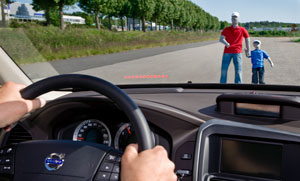
ROCKLEIGH, NJ – On a small test course adjacent to its headquarters here, Volvo Cars of North America LLC demonstrates its new pedestrian-protection technology with full autonomous braking.
The new system, which is engineered to automatically stop cars from hitting pedestrians at speeds of up to 16 mph (25 km/h), will be introduced in the ʼ11 Volvo S60 sedan that goes on sale in September.
The system consists of a camera behind the rearview mirror and a radar unit installed behind the front grille of the car. Camera optics are similar to the human eye.
”If you can see it, the camera can see it,” says Adam Kopstein, manager, automotive safety and compliance for VCNA. The camera detects objects 164 ft. (50 m) ahead of the vehicle and has a 45-degree field of view.
The radar has a 60-degree field of view and can “see” 500-650 ft. (150-200 m) down the road.
Both the camera and radar are always on when the S60 is moving. Volvo engineers worked for a decade with Delphi Corp. to create the system. Algorithms were devised to recognize human head, neck, legs and shoulders of all sizes and shapes.
In a test drive, the system works as advertised – ultimately. That's because it's difficult to restrain reflexive braking when approaching an obstacle – even a dummy – in the road ahead.

The new pedestrian safety system stops the vehicle without the driver stepping on the brake. In the test at 16 mph, full braking force is applied to stop the vehicle about 4 ft. (1.2 m) in front of the dummy.
Kopstein says that the new system will reduce speed by 16 mph, regardless of how fast the vehicle is traveling. But it will only fully stop the vehicle from 2 to 16 mph.
The pedestrian-detection system differs from Volvo's City Safety System that's available only in the XC60 model at this time. City Safety applies 50% of braking force to prevent frontal collisions with another vehicle. It is not capable of recognizing and stopping for pedestrians.
Volvo says there shouldn’t be concerns about potentially adverse effects from the radiation emitted by the radar unit in the pedestrian system.
"The emitted power from the radar is significantly below the legal thresholds of any region of the world,” says Thomas Brobeg of the Volvo Safety Center in Gothenburg, Sweden. “Vehicle and pedestrian detection in the 76 GHz band requires only little radio power output.
“The radar that is used for pedestrian detection in the coming S60 puts out significantly less power than a standard Bluetooth headset. A hundred Volvo S60s with pedestrian detection will emit less radio power than one cell phone.”
The pedestrian safety system brings Volvo a step closer to its announced goal of preventing auto fatalities completely in any Volvo by 2020.
Kopstein says 4,700 pedestrians were killed in the U.S. by motor vehicles in 2007, according to National Highway Traffic Safety Admin. data.
In many urban areas, pedestrian fatalities occur in collisions with vehicles traveling at relatively slow speeds, the auto maker says.

